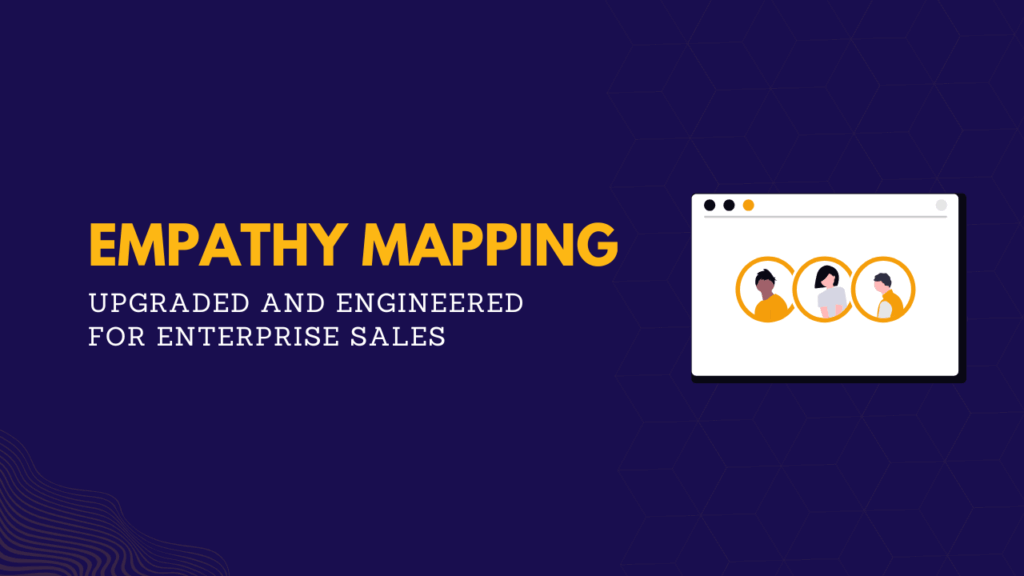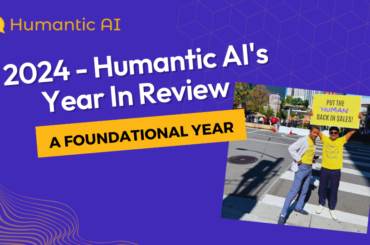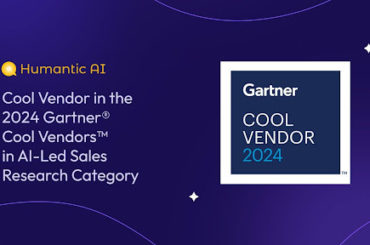Harness Humantic AI’s real-time personality insights to transform sales execution — personalize outreach, accelerate deal cycles, and consistently exceed quota goals.
In the pre-GPS era, navigating meant unfolding oversized paper maps, deciphering faded lines, and still asking a stranger for directions. It was slow, imprecise, and error-prone.
Sales used to be the same — guided by broad persona, gut instincts, and a whole lot of guesswork.
Today, GPS technology removes guesswork from navigation, providing real-time traffic updates, path guidance, and alternate routes.
In 2025, navigation has evolved, but what about sales? Not so much. Despite the data boom, sales teams are still navigating the dynamic buyer journey with a static, one-size-fits-all approach.
The result? Seller quota attainment is at a record low. In 2024, a staggering 69% of sales reps missed their quota (Pavilion). This disparity was not due to laziness or a lack of data, but rather due to inadequate buyer understanding.
Meanwhile, top-performing teams — the ones who truly understood their buyers — outpaced their counterparts by up to 2100%. Their secret? Relevance. Not just persona-level intel, but person-level insights.
How would it be if sellers had the same, GPS-kind of understanding about each of their buyers? They would walk into every meeting knowing how to build trust, handle objections, and speak their buyer’s language.
That’s where modern empathy mapping comes in — it’s not just a map, it’s the GPS of buyer understanding.
In this post, we’ll break down what empathy maps are, how they’ve evolved, why they’re often overlooked in enterprise sales, and how they’re being reshaped to meet today’s selling reality.
What Is Empathy Mapping?
Sales teams often say it’s all about understanding the buyer. But how often do they really mean it?
They’ve got the data, from demographic segments to detailed personas. But none of it captures what truly drives a buyer to say yes… or why they ignore their fourth follow-up.
Empathy mapping bridges this gap. Originally rooted in design thinking, this framework is surprisingly relevant in sales. Empathy mapping helps you stop selling to personas and start selling to people. It’s structured around four quadrants — Thinks, Feels, Says, and Sees/Does.
In today’s internet-driven sales contexts, each of these can be decoded from digital signals like CRM activity, website behavior, or even a LinkedIn comment.
Here’s how it maps:
| The Quadrant | Digital Signal Examples |
| Thinks: What are they thinking? What are their priorities or fears? | CRM activity patterns, Product usage level, LinkedIn comments/likes |
| Feels: Their emotional drivers: risk-averse, ambitious, frustrated | Churn risk behavior, Feedback in product chat or support tickets, Tone in emails/CRM notes |
| Says: What are they saying? | Interviews, Email responses, Sales call transcripts |
| Sees/Does: What actions are they taking that reveal intent, friction, or interest? | Website page visits, Ad engagement, Demo requests, Assets consumption pattern |
These digital cues, when structured in an empathy map, act like a strategic lens through which sellers can interpret buyers’ intent, resistance, and decision velocity.
It helps sellers walk a mile in their buyers’ shoes and get a definite understanding of their goals, frustrations, behaviors, and motivations. Instead of relying on vague personas or generalized assumptions, empathy maps surface every buyer’s emotional and psychological drivers.
Using this information, sellers can tailor their messaging, timing, and tactics to suit each buyer’s mindset — not just their job title.
But here’s the catch: traditional empathy maps are static, need manual interference, and lack real-time behavioral data. Which means they lose relevance when buyer behaviors shift or accounts change.
This process was once tedious — until Humantic AI automated it. Imagine having a real-time empathy map for every buyer in your pipeline with up-to-date behavioral and psychographic insights integrated and — generated in just a few seconds.
That’s precisely what top-performing sales teams are doing. They’re turning to Personality AI platforms like Humantic AI to continuously decipher buyer psychology and surface timely, contextual intelligence.
The result? This approach leads to a deeper understanding, faster trust, and a deal velocity that remains constant.
Why Do You Need Empathy Mapping In Sales?
Now that we’ve broken down the anatomy of a modern empathy map, let’s talk about why it’s mission-critical in high-stakes sales environments.
According to a Salesforce report, 84% of customers said being treated like a person, not a number, is important to winning their business.
Most sales organizations have a boatload of buyer data — CRM fields, email history, LinkedIn activity, sales call transcripts, and whatnot. But they still run on an insight deficit.
In an era where AI fills our dashboards with data, the key to high-impact selling remains unchanged: a deep understanding of the human behind the decision.
“90% of C-suite executives don’t respond to impersonal B2B sales, choosing instead to engage more selectively with those they trust” (LinkedIn).
Guided by buyer intelligence, empathy mapping uncovers the crucial element – subtle personality differences that drive decisions. The result translates directly into more effective, personalized selling and, ultimately, a healthier bottom line. Together they:
- Improve cold email performance by personalizing tone and messaging with the individual buyer’s personality, boosting open and reply rates.
- Speed up deal cycles by minimizing resistance in key decision moments, using insights that preempt objections before they surface.
- Manage and align multiple stakeholders by understanding and addressing each stakeholder’s unique concerns, priorities, and influence.
- Reduce no-shows by adapting outreach to a buyer’s preferred communication style — channel, timing, and tone.
- Increase ACV by tailoring pitch decks and business cases to each stakeholder’s priorities.
Empathy Mapping: From Understanding To Action
Sales is a fast-paced, demanding job. In enterprise environments, reps manage thousands of accounts and complex buying journeys. Traditional empathy mapping falls short for two key reasons:
- It’s hard to scale across thousands of leads.
- It’s not updated frequently enough to remain useful.
And there’s a third, often ignored challenge: time. Enterprise sales cycles can stretch over several months or even quarters. During that time, what if the champion leaves? Or the CFO suddenly gets involved? The map quickly becomes a fossil, and months of effort by sales teams go down the drain.
This is the problem that Humantic AI solves. The platform helps sellers create living empathy maps using 160+ behavioral signals, combining ML & AI with Social & IO Psychology, Computational Linguistics and Psycholinguistics. It delivers personality-based guidance — including buyer’s DISC profile and Big Five traits — to sales teams, tailored to the stage of the deal.
To put it simply, Humantic AI transforms static empathy maps into dynamic, real-time buyer intelligence.
Instead of relying on one-time mapping exercises, reps now get always-fresh insights into a buyer’s personality, communication preferences, and buying styles — directly into their sales tech stack.
This is how sales differ with vs. without Humantic AI:
| Without Humantic AI | With Humantic AI | |
| Prospect Research | Google-stalking, LinkedIn-lurking | Instant personality snapshot, communication do’s and don’ts |
| Lead Assignment | Based on territory or alphabetic logic | Assigned by the best rep–buyer personality match |
| Cold Outreach Emails | Generic templates like, “Hey {{FirstName}}, saw you’re crushing it on LinkedIn.” | Emails matched to tone, interests, and decision-making style |
| Objection Handling | Defaulting to standard rebuttals | Buyer-type-specific responses (yes, it’s a thing) |
| CRM Notes | “Likes golf. Nice guy.” | Behavioral tags like Introvert, Skeptical, Detail-oriented, or Send facts, not fluff. |
Empathy Maps In Action: Sales Use Cases
Here are a few ways in which empathy mapping with personality AI works:
Sales Use Case 1: Win/Loss Analysis
The old way: When asked why a deal fell through, Sales Reps would blame price, product, and/or time.
The Humantic AI way: Through DISC profiling and Personality AI algorithms, Humantic AI analyzes traits of every stakeholder involved in a deal. Using this information, sales and/or data teams can segment buyers by psychographics, score leads using win/loss patterns, and identify which personality types are most likely to convert.
Case in point: Domo, a NASDAQ-listed Data Experience platform, recorded a 22% increase in its overall win rate after deploying Humantic AI in its tech stack. Besides this, it leveraged enriched data to develop a finer understanding of its ICP and studied patterns across customers it won or lost more often with.
Sales Use Case 2: Cold Email Personalization — At Scale
The old way: Generic, templatized outreach based on the prospect’s LinkedIn profile.
The Humantic AI way: The platform analyzes 160+ behavioral signals to compute a prospect’s personality type and facilitates the creation of highly personalized emails. These messages are infused with specific linguistic cues, a matching tone, and contextual relevance to increase the likelihood of a positive response and avoid potential communication pitfalls.
Case in point: PayPal decreased its time-to-first engagement by a whopping 36% after employing personalization-at-scale powered by behavioral insights from Humantic AI.
Sales Use Case 3: Buying Committee Management
The old way: Same messaging for every persona in an enterprise sales scenario.
The Humantic AI way: With Humantic AI, sales reps or AEs can comprehensively understand each buying committee member beyond their professional profile. This helps them to proactively address concerns of every persona, identify and cultivate champions, and strategically navigate the group dynamics to close deals ASAP.
Case in point: A Fortune 50 company leveraged Humantic AI and added $26 million in additional sales in 45 days. The enterprise sales team was able to identify skeptics and friendlies in the large, complex buying cycle and anticipate objections and negotiations on key opportunities.
Likewise, personality AI can be leveraged across the sales funnel — from prospecting to negotiations — to improve outcomes at every stage.
Go From Generic To Genuinely Impactful With Humantic AI
In today’s buyer-led market, teams that don’t prioritize and master buyer experience risk falling behind, losing ground to competitors, or otherwise. Empathy mapping is foundational to any sales team that wants to adopt a buyer-centric approach.
Humantic AI can make this adoption easier. It’s a buyer experience platform that empowers sellers to help buyers buy more. It helps them understand how individual buyers make decisions — what influences them, what deters them, and how to approach them effectively.
With Humantic AI, sales teams can walk into every meeting prepared with person-level insights that lead to more meaningful conversations, fewer surprises, faster buying cycles, and more deals closed. On average, teams see up to a 109% increase in pipeline after adopting the platform.
High-impact sales teams at AWS, GitLab, Sandler, and Cushman rely on Humantic AI to turn buyer experience into a competitive advantage.
To see what’s possible with Humantic AI, book a demo or try it for free.



